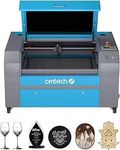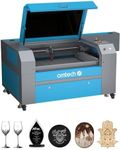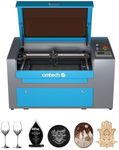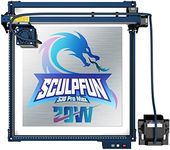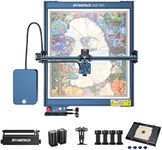Buying Guide for the Best Budget Laser Engraver
Choosing the right budget laser engraver can be a rewarding experience if you know what to look for. Laser engravers are versatile tools that can be used for a variety of projects, from crafting personalized gifts to creating intricate designs on different materials. To make an informed decision, it's important to understand the key specifications and how they align with your needs. Here are the main specs to consider when selecting a budget laser engraver.Laser PowerLaser power, measured in watts, determines the strength and capability of the laser engraver. Higher wattage means the laser can cut through thicker materials and engrave faster. For light engraving on materials like paper, leather, or thin wood, a lower wattage (around 5-10 watts) is sufficient. For more demanding tasks like cutting through thicker wood or acrylic, you might need a laser with 20-40 watts. Consider what materials you plan to work with and choose a laser power that matches those needs.
Engraving AreaThe engraving area is the maximum size of the material that the laser can work on at one time. This is important because it determines the size of the projects you can create. Smaller engravers might have an area of around 4x4 inches, suitable for small crafts and jewelry. Larger models can offer areas of 12x20 inches or more, which are better for bigger projects like signs or large artwork. Think about the typical size of your projects and choose an engraver with an appropriate engraving area.
Material CompatibilityDifferent laser engravers are compatible with different materials. Common materials include wood, acrylic, leather, fabric, and metal. Some engravers are versatile and can handle a wide range of materials, while others are more specialized. If you plan to work with a variety of materials, look for an engraver that supports multiple types. If you have a specific material in mind, ensure the engraver is designed to work well with it.
Software CompatibilityLaser engravers come with software that allows you to design and control the engraving process. It's important to choose an engraver with software that is user-friendly and compatible with your computer system. Some software offers more advanced features like image tracing and vector graphics support. If you're a beginner, look for software that is easy to learn and has good customer support. If you're more experienced, you might want software with more advanced capabilities.
Precision and ResolutionPrecision and resolution refer to the detail and accuracy of the engravings. Higher resolution means finer details and smoother curves. This is measured in dots per inch (DPI). For most hobbyist projects, a resolution of 300-600 DPI is adequate. For highly detailed work, such as intricate designs or small text, you might want a higher resolution of 1000 DPI or more. Consider the level of detail required for your projects when choosing the resolution.
Safety FeaturesSafety is crucial when working with laser engravers, as they involve high-powered lasers. Look for features like protective enclosures, emergency stop buttons, and safety interlocks that prevent the laser from operating if the cover is open. These features help prevent accidents and ensure safe operation. If you have children or pets around, these safety features become even more important.
Build Quality and DurabilityThe build quality and durability of the laser engraver affect its longevity and performance. Look for engravers made from sturdy materials like metal or high-quality plastic. Check for reviews on the reliability and durability of the model. A well-built engraver will last longer and provide consistent performance over time. If you plan to use the engraver frequently, investing in a durable model is essential.

